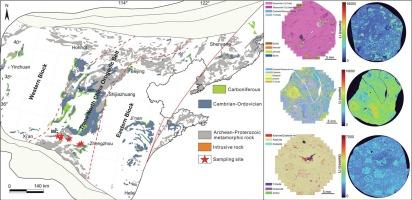华北克拉通晚石炭世地层中原生锂矿物库克石的成因
IF 3.6
2区 地球科学
Q1 GEOLOGY
引用次数: 0
摘要
锂(Li)对于推进全球绿色能源转型至关重要。随着对这一关键元素需求的增长,寻找新的和非常规的锂资源变得越来越重要。在华北克拉通(NCC)晚石炭世地层中,我们研究了一个铝土矿沉积锂矿床,其中富含锂的层状硅酸盐层含有高达6782 ppm的锂。矿物学和地球化学分析表明,Li主要赋存于炊事岩中,主要来自白云母II型,少量来自榴辉石。通过x射线衍射(XRD)特征峰(14.03,7.03,3.51和1.49 Å),激光诱导击穿光谱(LIBS)和激光烧蚀电感耦合等离子体质谱(LA-ICP-MS)图谱以及傅里叶变换红外光谱(FTIR)特征显示富li域之间的空间相关性,对Cookeite进行了鉴定。富li域3532-3516和3355-3335 cm−1的宽FTIR波段反映了Li-Al水镁石样层中的OH拉伸,证实了cookeite。TESCAN集成矿物分析仪(TIMA)提供了结构背景,显示库克石是离散的颗粒,与高岭石和白云石共生,通常形成自生起源的星爆聚集体。NCC铝土矿中的锂富集反映了三个阶段的演化过程:碎屑硅酸盐的风化释放、库克岩和缺钾白云母II型的成岩结晶,以及晚期热液叠印使Li沿裂缝和泥质/鲕状构造与Ti氧化物进行升级。该层序强调了风化作用、成岩作用和热液作用对锂富集的综合作用。这些发现强调了在北陆晚石炭世铝土矿床中,cookkeite作为原生含锂矿物的重要意义。更广泛地说,本研究为全球范围内寻找类似的岩溶矿床提供了一个框架,其中库克矿、锂白云母和钛氧化物可能作为关键的勘探指标。LIBS和FTIR被证明是识别细粒样品中含锂相的有效工具,为有针对性的锂勘探提供了快速和经济的支持。本文章由计算机程序翻译,如有差异,请以英文原文为准。

Genesis of cookeite, the primary lithium mineral in the Late Carboniferous strata of the North China Craton
Lithium (Li) is essential for advancing the global green energy transition. As demand for this critical element grows, identifying new and unconventional Li resources has become increasingly important. Here we investigate a bauxitic sedimentary Li deposit in the Late Carboniferous strata of the North China Craton (NCC), where Li-enriched phyllosilicate layers contain up to 6782 ppm Li. Mineralogical and geochemical analyses show that Li is mainly hosted in cookeite, with significant contributions from Muscovite II and minor amounts from elbaite. Cookeite was identified by characteristic X-ray diffraction (XRD) peaks (14.03, 7.03, 3.51, and 1.49 Å), supported by spatial correlations between Li-enriched domains revealed by Laser-Induced Breakdown Spectroscopy (LIBS) and Laser Ablation Inductively Coupled Plasma Mass Spectrometry (LA-ICP-MS) mapping, and by Fourier Transform Infrared Spectroscopy (FTIR) signatures. Broad FTIR bands at 3532–3516 and 3355–3335 cm−1 in Li-rich domains reflect OH stretching in Li–Al brucite-like layers, confirming cookeite. TESCAN Integrated Mineral Analyzer (TIMA) provided textural context, showing cookeite as discrete grains and intergrowths with kaolinite and muscovite, commonly forming starburst aggregates of authigenic origin. Lithium enrichment in the NCC bauxites reflects a three-stage evolution: weathering release from detrital silicates, diagenetic crystallization of cookeite and K-deficient Muscovite II, and late hydrothermal overprint that upgraded Li along fractures and pisolitic/oolitic structures with Ti oxides. This sequence underscores the combined roles of weathering, diagenesis, and hydrothermal processes in concentrating Li. These findings emphasize the significance of cookeite as the primary Li-bearing mineral in Late Carboniferous bauxitic deposits of the NCC. More broadly, this study provides a framework for exploring similar karst-hosted deposits worldwide, where cookeite, Li-muscovite, and Ti oxides may serve as key exploration indicators. LIBS and FTIR are shown to be efficient tools for identifying Li-bearing phases in fine-grained samples, offering rapid and cost-effective support for targeted Li exploration.
求助全文
通过发布文献求助,成功后即可免费获取论文全文。
去求助
来源期刊

Ore Geology Reviews
地学-地质学
CiteScore
6.50
自引率
27.30%
发文量
546
审稿时长
22.9 weeks
期刊介绍:
Ore Geology Reviews aims to familiarize all earth scientists with recent advances in a number of interconnected disciplines related to the study of, and search for, ore deposits. The reviews range from brief to longer contributions, but the journal preferentially publishes manuscripts that fill the niche between the commonly shorter journal articles and the comprehensive book coverages, and thus has a special appeal to many authors and readers.
 求助内容:
求助内容: 应助结果提醒方式:
应助结果提醒方式:


